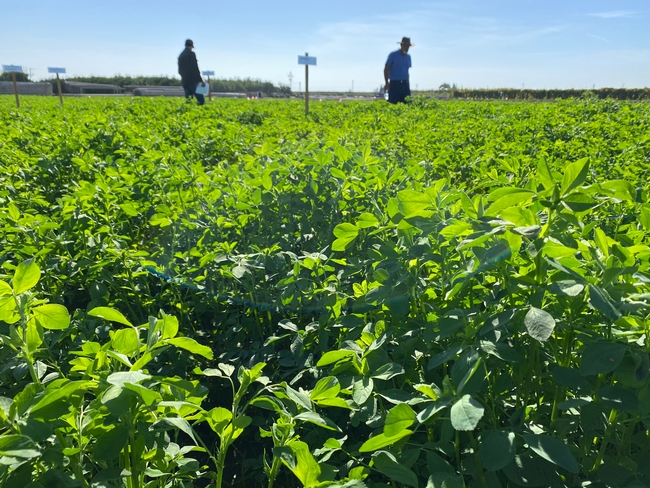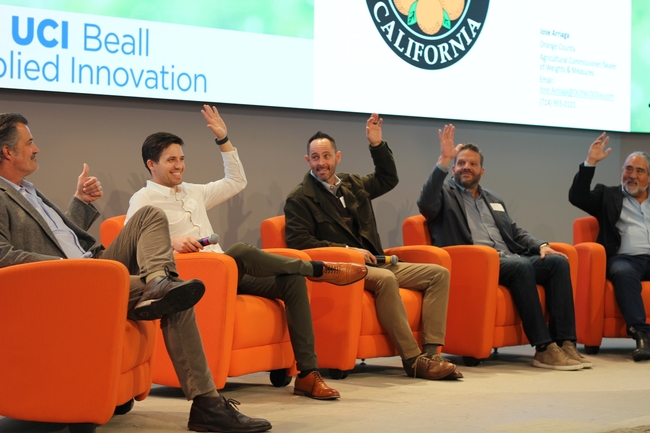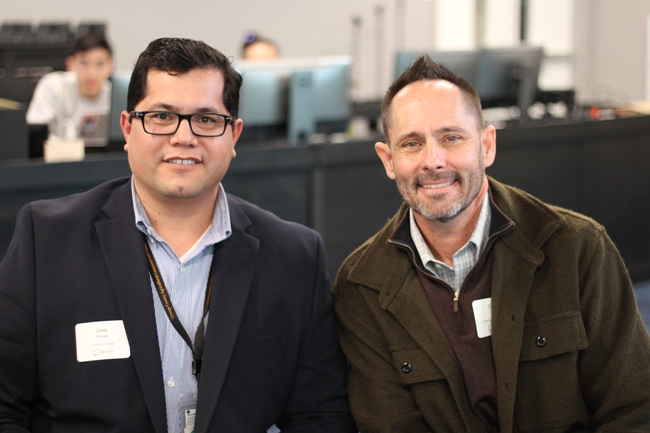Posts Tagged: SoCal
Lawn-pocalypse! Surviving Drought
Ah, summer! The season of sunburns, pool parties, and… lawn droughts. If your once lush, green carpet now looks like a crunchy brown doormat, you're not alone. Let's dive into why your yard is staging a dramatic death scene and what you can do to...

Bermuda grass and weeds overtaking drought stressed turf grass.
$1.7M granted for climate-smart planning led by UC ANR scientists
In California, natural and working lands make up 95 million acres of the state and play a vital role in building resilience to the impacts of climate change. University of California Agriculture and Natural Resources was awarded $1.7 million for the California Next Generation and Equitable Climate Action Plan, as part of the state's Natural and Working Lands Climate Smart Strategy and California's 30x30 Initiative, an effort to conserve 30% of the state's lands and coastal waters by 2030.
Natural and working lands include both unmanaged and managed areas actively used for agriculture, forestry or production purposes.
Chandra Richards, UC Cooperative Extension agricultural land acquisitions academic coordinator for Southern California, and Cristina Murillo-Barrick, UCCE's Black, Indigenous and People of Color community development advisor for the Bay Area, are leading the California Next Generation and Equitable Climate Action Plan project.
To build capacity and technical assistance for climate-smart action planning, Richards and Murillo-Barrick will use the Climate Smart Land Management Program funding, awarded through the California Department of Conservation, to focus on two of the most pressing climate action issues: equitable land access and land management diversification.
According to the 2022 U.S. Department of Agriculture census, demographic data indicates that California agricultural land ownership and production is concentrated within an aging and mostly White demographic. However, research suggests diverse management practices promote healthy landscapes. This has been shown to benefit the environment, human health and climate resilience in multiple ways.
For this reason, this project centers on “historically underrepresented communities,” a term that includes California Native American Tribes, communities of color, landless farmers, immigrant and non-English speaking communities and other agency-designated minority groups (racial, ethnic and non-male groups, socially disadvantaged farmers and ranchers, and California designated severely disadvantaged communities).
Focusing on Southern California, UC Cooperative Extension scientists will identify barriers to land access, management and opportunities to increase land manager diversity. They also will engage historically underrepresented communities in coalition building, capacity assessment and climate action planning.
Within the last few decades, Californians have faced increased ecosystem stressors and decreasing diversity of natural systems. This pattern continues to damage already-vulnerable communities (disproportionately historically underrepresented communities), while also worsening and intensifying climate impacts, including drought, wildfire, flooding and disease. Overcoming these kinds of systemic and structural challenges will require the next generation of land managers to reflect California equitably, while preparing them to take on climate resilience. The project will determine clear solutions and plans that enable long-term, strategic land use and protection.
To do this work, UCCE is collaborating with the Community Alliance with Family Farms (CAFF), California Association of Resource Conservation Districts (CARCD) and the California Bountiful Foundation, all of whom serve as subgrantees and will deepen connections with communities.
Organizations like CARCD have long served as “boots on the ground” personnel and have close relationships with landowners and land managers. “RCDs have been hearing the land equity need for a long time and are actively collaborating with different partners to tackle this pressing issue,” said Qi Zhou, program manager of Justice, Equity, Diversity and Inclusion at CARCD and member of the Strategic Growth Council Land Equity Task Force.
“California RCDs are excited about this project because it will allow major California agriculture and conservation partners to collaboratively develop plans and implement projects centering on equity land access and land management diversification,” Zhou added.
Project lead Richards said $270,000 of the grant will be reserved for new partnerships with organizations in Southern California that have experience with, and strong ties to, historically underserved communities.
UC ANR is collaborating with the California Department of Food and Agriculture as well as California Climate and Agriculture Network (CalCAN), and World Be Well, a Southern California nonprofit.
Tawny Mata, CDFA's director of the Office of Environmental Farming and Innovation, described technical assistance providers as being grounded in their local agricultural communities and recognized their importance to partners in the success of CDFA's incentive programs.
“When we do succeed in reaching historically underserved farmers and ranchers with our grant programs, it is often with the thoughtful support and planning of a technical assistance provider,” Mata said. “I look forward to this project helping us refine our own technical assistance funding programs and bringing technical assistance providers together to network and share best practices for improving land access and promoting climate-smart agriculture.”
“The successes of this project will elevate the voices of historically underrepresented communities, strengthening efforts in these communities to support climate action,” said Richards. Additionally, the project will increase sharing of regional reports, needs assessments and community plans surrounding climate-smart management practices. Finally, it will boost technical assistance for these groups specifically.
To learn more about the Climate Smart Land Management Program and this year's awardees, visit:
REC System Director Haver encourages systemic approach to agriculture
Agriculture generates $59 billion and employs nearly 400,000 individuals in California. The industry, however, is often threatened by challenges like climate change, land conversion and water scarcity. Motivated to act, Sustain Southern California – an organization associated with UC Irvine Beall Applied Innovation – hosted a roundtable discussion on Feb. 20 featuring subject matter experts including Darren Haver, director of UC Agriculture and Natural Resources' Research and Extension Center System.
During his keynote address, Jose Arriaga, Orange County Agricultural Commissioner, defined sustainability as food and fiber production that does not compromise the ability for future generations to meet their needs. In doing so, he acknowledged the benefit of discussing such timely topics with key players, especially for places where agriculture is not as prevalent as it used to be.
“Many people don't think of Orange County as a place for agriculture. It's probably because less land is being reserved for agriculture, not like back in the day. And that worries me,” said Arriaga.
The first roundtable discussion centered on sustainable agriculture, with Haver participating alongside other industry leaders based in Southern California, including A.G. Kawamura of Orange County Produce, Steve Brazeel of Sunterra Produce and Elevated Foods, Anthony Curci of Buttonwood Ranch and Parker Cohn from Performance Resource Management.
In discussing today's generation, Haver said that he has seen a shift over the last few decades away from yield alone, which used to be the most important aspect of production in agriculture. Today, much more attention is dedicated to sustainability – a change that Haver attributes to the younger generation of researchers and plant scientists working in agriculture.
There has also been an emphasis on sustaining the environment while maintaining economic progress. Haver recognized these important elements, but highlighted the social impact of sustainability, too.
“I don't have all the answers, but I do believe that addressing the environmental, economic and social aspects of agriculture is important. I also think that these factors should be addressed systemically rather than in silos,” said Haver.
Southern California agricultural producers, in particular, are responsible for $7.8 billion in gross receipts and nearly 100,000 jobs directly related to agriculture. In Orange County alone, where Haver is based at the South Coast Research and Extension Center, agriculture makes up $86 million of total economic output, with nurseries leading as a top commodity followed by fruit trees, vegetable production and livestock and apiary.
Climate-Change Resources
University of California UC ANR Green Blog (Climate Change and Other Topics) https://ucanr.edu/blogs/Green/index.cfm?tagname=climate%20change (full index)
Examples:
- Save Trees First: Tips to Keep Them Alive Under Drought https://ucanr.edu/b/~CdD
- Landscaping with Fire Exposure in Mind: https://ucanr.edu/b/~G4D
- Cities in California Inland Areas Must Make Street Tree Changes to adapt to Future Climate https://ucanr.edu/b/~oF7
Drought, Climate Change and California Water Management Ted Grantham, UC Cooperative Extension specialist (23 minutes) https://youtu.be/dlimj75Wn9Q
Climate Variability and Change: Trends and Impacts on CA Agriculture Tapan Pathak, UC Cooperative Extension specialist (24 minutes) https://youtu.be/bIHI0yqqQJc
California Institute for Water Resources (links to blogs, talks, podcasts, water experts, etc.) https://ciwr.ucanr.edu/California_Drought_Expertise/
UC ANR Wildfire Resources (publications, videos, etc.) https://ucanr.edu/News/For_the_media/Press_kits/Wildfire/ (main website)
-UC ANR Fire Resources and Information https://ucanr.edu/sites/fire/ (main website)
-Preparing Home Landscaping https://ucanr.edu/sites/fire/Prepare/Landscaping/
UC ANR Free Publications https://anrcatalog.ucanr.edu/ (main website)
- Benefits of Plants to Humans and Urban Ecosystems: https://anrcatalog.ucanr.edu/pdf/8726.pdf
-Keeping Plants Alive Under Drought and Water Restrictions (English version) https://anrcatalog.ucanr.edu/pdf/8553.pdf
(Spanish version) https://anrcatalog.ucanr.edu/pdf/8628.pdf
- Use of Graywater in Urban Landscapes https://anrcatalog.ucanr.edu/pdf/8536.pdf
- Sustainable Landscaping in California https://anrcatalog.ucanr.edu/pdf/8504.pdf
Other (Non-UC) Climate Change Resources
Urban Forests and Climate Change. Urban forests play an important role in climate change mitigation and adaptation. Active stewardship of a community's forestry assets can strengthen local resilience to climate change while creating more sustainable and desirable places to live. https://www.fs.usda.gov/ccrc/topics/urban-forests
Examining the Viability of Planting Trees to Mitigate Climate Change (plausible at the forest level) https://climate.nasa.gov/news/2927/examining-the-viability-of-planting-trees-to-help-mitigate-climate-change/
Reports and other information resources coordinated under the auspices of the United Nations and produced through the collaboration of thousands of international scientists to provide a clear and up to date view of the current state of scientific knowledge relevant to climate change. United Nations Climate Action
Scientific reports, programs, action movements and events related to climate change. National Center for Atmospheric Research (National Science Foundation)
Find useful reports, program information and other documents resulting from federally funded research and development into the behavior of the atmosphere and related physical, biological and social systems. Search and find climate data from prehistory through to an hour ago in the world's largest climate data archive. (Formerly the "Climatic Data Center") National Centers for Environmental Information (NOAA)
Think tank providing information, analysis, policy and solution development for addressing climate change and energy issues (formerly known as the: "Pew Center on Global Climate Change"). Center for Climate & Energy Solutions (C2ES)
Mapping Resilience: A Blueprint for Thriving in the Face of Climate Disaster. The Climate Adaptation Knowledge Exchange (CAKE) was launched in July 2010 and is managed by EcoAdapt, a non-profit with a singular mission: to create a robust future in the face of climate change by bringing together diverse players to reshape planning and management in response to rapid climate change. https://www.cakex.org/documents/mapping-resilience-blueprint-thriving-face-climate-disaster
Cal-Adapt provides a way to explore peer-reviewed data that portrays how climate change might affect California at the state and local level. We make this data available through downloads, visualizations, and the Cal-Adapt API for your research, outreach, and adaptation planning needs. Cal-Adapt is a collaboration between state agency funding programs, university and private sector researchers https://cal-adapt.org/
Find reports, maps, data and other resources produced through a confederation of the research arms of 13 Federal departments and agencies that carry out research and develop and maintain capabilities that support the Nation's response to global change. Global Change (U.S. Global Change Research Program)
The Pacific Institute is a global water think tank that combines science-based thought leadership with active outreach to influence local, national, and international efforts to develop sustainable water policies. https://pacinst.org/our-approach/
Making equity real in climate adaptation and community resilience policies and programs: a guidebook. https://greenlining.org/publications/2019/making-equity-real-in-climate-adaption-and-community-resilience-policies-and-programs-a-guidebook/
Quarterly CA Climate Updates and CA Drought Monitor Maps (updated each Thursday) https://www.drought.gov/documents/quarterly-climate-impacts-and-outlook-western-region-june-2022
Drought focus of Water Resources IMPACT magazine special issue
UC ANR experts address emotional toll of drought
Preparing the American West for prolonged drought is the focus of a double issue of Water Resources IMPACT magazine. The California Water Commission staff are guest editors for this special open-access edition of the magazine, which is published by the American Water Resources Association.
Faith Kearns, academic coordinator of University of California Agriculture and Natural Resources' California Institute for Water Resources, is among the authors delving into how drought impacts people and the environment and how we can better prepare for the inevitable.
The first issue, published on Feb. 14, focuses on water scarcity issues confronting California and the ways these issues affect different sectors.
In “Trauma, Care, and Solidarity: Addressing the Emotional Toll of Chronic Drought,” Kearns highlights the effects of drought on mental health. She points to the spike in suicide hotline calls when wells ran dry in Southeast Asian communities in California's Central Valley.
By listening to Southeast Asian farmers, Ruth Dahlquist-Willard and Michael Yang of UC Cooperative Extension were able to “lighten the load” for them by providing pragmatic support, Kearns writes.
“The scale of some of these highly emotional issues – drought, wildfires, climate change – can make them seem incredibly difficult, if not impossible, to deal with,” Kearns said. “At the same time, they are affecting everyone living in the western U.S. on a daily basis. I wanted to highlight and provide models based on work that people – whether they are researchers, clinical psychologists, or Cooperative Extension advisors – are doing right now to ease the way.”
The authors who contributed to the double issue are a diverse array of Tribal experts, academics, nongovernmental organization thought-leaders, water managers and water policy influencers, each of whom brings their own perspective on the topic of drought. Their expertise and perspectives in climate science, water policy and water management will help inform drought-related decision-making and support policies that better prepare the state to thrive during periods of prolonged water scarcity.
In addition to Kearns, the first issue includes articles contributed by:
- Samantha Stevenson, University of California, Santa Barbara
- Jay Lund, University of California, Davis
- Ron Goode, North Fork Mono Tribe
- Andy Fecko, Placer County Water Agency
- Jeff Mount, Public Policy Institute of California, and Ted Grantham, University of California, Berkeley/UC Cooperative Extension
- Nat Seavy and Karyn Stockdale, National Audubon Society
- Kjia Rivers, Community Water Center
- Cannon Michael, Bowles Farming
- Michelle Reimers, Turlock Irrigation District
The January/February edition of Water Resources IMPACT magazine can be accessed, free of charge, on the American Water Resources Association website at https://www.awra.org under “Publications.”
The second issue, to be published in March, will focus on drought response, considering the options for adaptation. This two-part series complements the Commission's work on strategies to protect communities and fish and wildlife in the event of a long-term drought.






